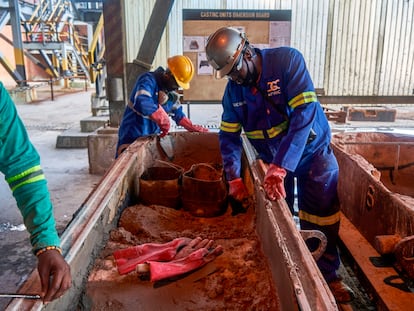Protests against the exploitation of a copper mine show the clash between two environmentalisms in Panama
The Central American country is the world’s fourteenth largest copper producer and has gained relevance as a result of increasing interest in electric energy as an alternative to fossil fuels

Thousands of Panamanians have taken to the streets to protest against a contract extension that would allow a Canadian company to continue extracting copper from a mine located in a protected biological corridor. For two weeks, the capital and other parts of the Central American country have been operating at a semi-standstill, and the tourism sector alone has taken nearly $200 million in losses. Pressure is mounting, and the protestors’ objective is clear: the extractivist policy must end to protect the environment, and they are demanding that the contract be canceled.
The market is on the opposite side of the protest, and it too is responding to the movement against climate change. To reduce carbon emissions, politicians and governments in many countries are proposing a switch to cars and machinery that run on electricity instead of gasoline; the former can be powered by renewable or cleaner sources. Because of its high conductivity, copper has become a key component in this energy transition, and demand for the material is expected to increase by 20% by 2035.
Experts say that the protests in Panama should be understood as more than an isolated reaction to the classic conflict between mining companies and local communities. This is a story destined to repeat itself in countries without a deep-rooted mining culture, prompting a complex debate over the overall benefits of electrification and the destination of the revenues that the material will generate.

Automotive companies such as Tesla, as well as renewable energy and power companies, already use Panamanian copper. Last year, First Quantum Minerals (FQM), the Canadian company that has been operating the mine since 1997, told clients that it estimated production of between 370,000 to 400,000 tons of copper from its mine in the Central American country by 2024. “Panama is a major contributor to global copper mine production, and in 2022 it was the world’s 14th largest copper-mine producing country,” Ana Rebelo, the director of analysis and statistics at the International Copper Study Group (ICSG), a Portugal-based intergovernmental organization, said by email.
“There hasn’t been any announcement about a pause in the Panama Copper mine’s production because, to my knowledge, debates are continuing in Congress,” Rebelo said. “In the event that the Panama Copper mine had to stop temporarily, it would of course affect our overall mine production forecast for 2024.″
Protests broke out in Panama on October 20, when Congress fast-tracked the law granting FQM’s local subsidiary a contract extension of up to 40 years, and the president immediately signed the bill into law. One of the arguments against this extension is that the public wasn’t consulted; as a result, the Supreme Court should declare it unconstitutional, opponents say. Four lawyers have filed the corresponding appeals, and the parties now await the Court’s decision.

“This is an example of what’s going to happen more frequently in the future, given that the demand for copper is going to increase and therefore we’re going to need to open more mines,” says Adrian Duhalt, a research scholar at the Center on Global Energy Policy at Columbia University in New York. “I anticipate that what [we] are seeing in Panama we are going to see more examples of in countries with similar contexts, such as in the rest of Central America, in Africa, in some South American countries.”
The academic notes that in countries like Chile, where mining is a long-standing economic activity, extraction is “socially accepted” to a certain extent. “But in contexts where a huge mining project has more visible environmental implications, we should naturally expect a reaction from society and environmental groups,” says Duhalt.
It is a clash of environmentalisms. Citizens living in countries rich in natural resources do not want to see a deterioration in their ecosystems or pollution derived from mining activities, even if that activity could lead to a global energy transition that would benefit the environment.
“Here, the social license to operate and dialogue with communities takes on strategic importance, because the transition has to be fair,” says Duhalt. That point aligns with the mining practices that multilateral organizations like the World Bank and the International Monetary Fund have been promoting for at least two decades. Duhalt points out that companies must reach out to communities to understand what their needs, their capabilities and their values are. “You can’t just impose your will simply because you won a concession,” he adds.
“We should not tolerate the fact that there are going to be [some] regions that have to sacrifice, and [other] regions that enjoy the benefits of the energy transition,” Duhalt argues. “All signs indicate that the demand for copper is going to continue to increase and the question is where are we going to get it from and under what conditions? To what extent are communities going to be affected? That is a very complex conversation that will gain traction in the coming years.”

Sign up for our weekly newsletter to get more English-language news coverage from EL PAÍS USA Edition
Tu suscripción se está usando en otro dispositivo
¿Quieres añadir otro usuario a tu suscripción?
Si continúas leyendo en este dispositivo, no se podrá leer en el otro.
FlechaTu suscripción se está usando en otro dispositivo y solo puedes acceder a EL PAÍS desde un dispositivo a la vez.
Si quieres compartir tu cuenta, cambia tu suscripción a la modalidad Premium, así podrás añadir otro usuario. Cada uno accederá con su propia cuenta de email, lo que os permitirá personalizar vuestra experiencia en EL PAÍS.
¿Tienes una suscripción de empresa? Accede aquí para contratar más cuentas.
En el caso de no saber quién está usando tu cuenta, te recomendamos cambiar tu contraseña aquí.
Si decides continuar compartiendo tu cuenta, este mensaje se mostrará en tu dispositivo y en el de la otra persona que está usando tu cuenta de forma indefinida, afectando a tu experiencia de lectura. Puedes consultar aquí los términos y condiciones de la suscripción digital.
More information
Archived In
Últimas noticias
Daytime, headphones, no booze involved: How a generation is saying ‘no’ to club parties
Millennia-old Yuracaré language resists extinction through 900 speakers and a new dictionary
Susan Boyle prepares a comeback just as Timothée Chalamet sings her praises
Trump suspends green card visa lottery after shooting at Brown University
Most viewed
- Christian Louboutin: ‘Young people don’t want to be like their parents. And if their parents wear sneakers, they’re going to look for something else’
- Cartels in Mexico take a leap forward with narco-drones: ‘It is criminal groups that are leading the innovation race’
- Liset Menéndez de la Prida, neuroscientist: ‘It’s not normal to constantly seek pleasure; it’s important to be bored, to be calm’
- ‘El Limones’ and the growing union disguise of Mexican organized crime
- US sanctions against jailed cartel leader ‘El Marro’ highlight Mexico’s lack of control over its prisons











































